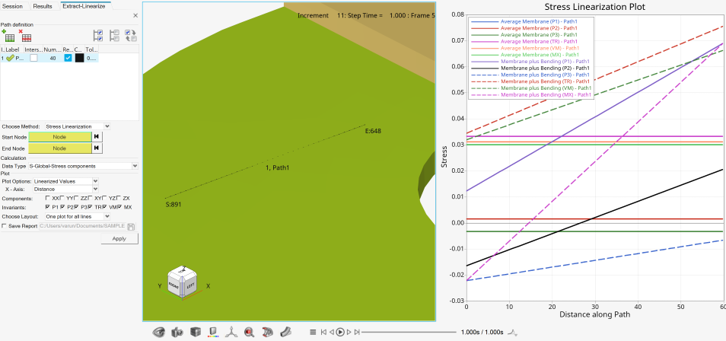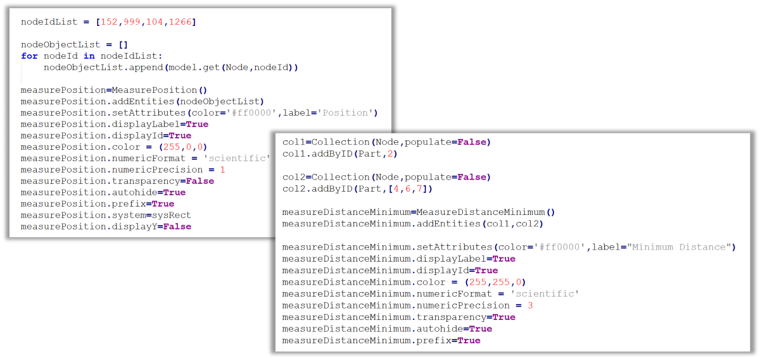Altair HyperView 2024.1 Release Notes
General
Highlights
- Extract and Linearize tool is supported in HyperView-MultiCore profile.
- The H3D export option has been enhanced to include 3D Model export, supporting GLB files and new a HTML player.
- Enhancements to HyperView Measures, Notes, and Section Cut tools.
New Features
- Extract and Linearize toolThis tool is used to extract contour values at any point along a path and/or perform stress or strain linearization, is now supported in the HyperView – MultiCore profile. The workflow remains the same, however performance will be enhanced due to the faster loading of data in the MultiCore profile.
Figure 1. 
- 3D Model ExportThe H3D export option dialog in HyperView has been upgraded by adding more formats and options to encourage collaboration across Engineering teams.
- HyperView introduces the creation of GLB files, which are a binary form of GLTF, that can be used for reviewing 3D model, animations and result plots outside of HyperView in any viewer that supports GLB files. This can also be useful for VR, AR and 3D printing applications. GLB files can be viewed using Microsoft 3D Viewer, Microsoft Office and many other tools available in the market.
- HyperView also introduces a method to export 3D model into HTML files. The data format is rich where you can query values on each entity and also create section cuts, callouts and exploded views for deeper results insights. The HTML file is self-contained with both model and viewer. This replaces a previously retired H3D capability to embed H3D into HTML files that used to require a HyperView Player installation in order to view it. It is supported on all modern day browsers such as Chrome, Firefox, Edge and Safari.
- Both above methods of model data do not need any software
installation to view the files.
Figure 2. 
- Python API
The Python API layer has been expanded to support measures, systems and video capture.
- The System() class supports rectangular, cylindrical and spherical
systems.
Figure 3. 
- Overall, 16 Measure Classes where introduced:
- MeasureStaticMinMax(), MeasureDynamicMinMax()
- MeasurePosition()
- MeasureDistanceBetween(), MeasureDistanceIncremental(), MeasureDistanceMinimum() and MeasureDisplacementRelative()
- MeasureAngleBetween(), MeasureAngleRelative() and MeasureAngleIncremental()
- MeasureCircleRadius()
- MeasureContourElemental(), MeasureContourNodal() and MesureContourComponent()
- MeasureYawPitchRoll()
- MeasureNodePath()
Figure 4. 
- The CaptureVideoTool() Class supports the export of videos in 'avi',
'amf' and 'gif' format:
Figure 5. 
More information can be found in the Python API Reference Guide section of API, Reference Guides.
- The System() class supports rectangular, cylindrical and spherical
systems.
- HWC console performance improvements for long
commands
If a HWC command exceeds a certain length (currently 1000 characters) it will show a trimmed version of the command both in the command line and the time history. Copying from the history will always get the full command.
Enhancements
- In Section cut tool, a micro dialog is introduced to input a value and increment or decrement the cut plane location.
- In Measure tool, the option to edit a measure group and add new measures to it is added.
- The ability to set measure numeric precision/format/angle units via preference statements is added.
- The style of the line connecting a Note to the entity can be set to either continuous (portion of the line that is hidden behind the model will be solid) or stipple (portion will be dashed). Previously only stipple option was available.
- Entity selector setting will be maintained across windows and models. For example, if the entity selector is set to Nodes in window 1, it will be maintained after switching to window 2.
- A new templex expression is added to display the full label of the time step of a Steps-based Derived loadcase inside a Note. The expression is {window.simulationparent} and is listed as DLC simulation title in the Field Names dialog.
Resolved Issues
- Slow performance of Quick Hotspot tool on large models in linear or modal animation mode.
- Application crashes after double clicking on Impact point found by IP Impact Post Safety tool.
- Error message when plotting strain tensor via Tcl command on some models in HyperView-MultiCore profile.
- Segmentation error when opening some Abaqus ODB files due to long element pool names.
- N1,N2,N3 selection option in Section Cut tool not working properly.
- HWC Console grabs focus while running HWC commands in Tcl format.
Solver Interfaces
Nastran Interface
Enhancements
- OP2 reader enhancement to support Axisymmetry results from NX Nastran.
OptiStruct Interface
Enhancements
- Support OS Time History "EDEM coupling force" and "MSI coupling force" data.
- Acoustic Acceleration, Velocity and Pressure results from HDF5 output format.
Extensions
Resolved Issues
- Removing and re-adding extensions now works properly. Re-added extensions now appear in the ribbons, toolbars, and menus as expected.